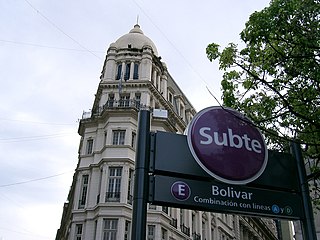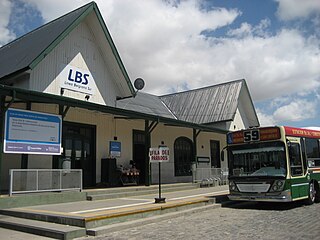
The Buenos Aires Underground, locally known as Subte, is a rapid transit system that serves the area of the city of Buenos Aires, Argentina. The first section of this network opened in 1913, making it the 13th earliest subway network in the world and the first underground railway in Latin America, the Southern Hemisphere, and the Spanish-speaking world, with the Madrid Metro opening nearly six years later, in 1919. As of 2023, Buenos Aires is the only Argentine city with a metro system.

Line F is a planned addition to the Buenos Aires Underground. In 2019, the government of Buenos Aires was looking for a group to create a plan of the line, but this study was cancelled in 2022. The city decided to create a study with their own staff, which is still underway as of 2024. The estimated cost of the project has risen from 800 million dollars, to 2 billion USD.

Line A is the oldest line of the Buenos Aires Underground. Opened to the public on 1 December 1913, it was the first underground line in South America, the Southern Hemisphere and the Spanish-speaking world. It made Buenos Aires the 13th city in the world to have an underground transport service. The line stretches 9.8 km (6.1 mi) from Plaza de Mayo and San Pedrito and runs under the full length of the Avenida de Mayo and part of the Avenida Rivadavia, and is used by 258,000 people per day.

Line B of the Buenos Aires Underground runs 11.75 kilometres (7.30 mi) from Leandro N. Alem to Juan Manuel de Rosas in Villa Urquiza. Line B opened to the public on 17 October 1930.

Line C of the Buenos Aires Underground, that runs from Retiro to Constitución terminus, opened on 9 November 1934, and it has a length of 4.3 km (2.7 mi). It runs under Lima Sur, Bernardo de Irigoyen, Carlos Pellegrini, Esmeralda, la Plaza San Martín and Avenida Ramos Mejia streets. It not only connects to every other line on the system, but its termini at Retiro and Constitución also connect it to some of the most important commuter rail networks in Buenos Aires, such as the Mitre and Roca lines and also long-distance passenger services. It is thus an important artery in Buenos Aires' transport system. At the same time, it is also the shortest line in both terms of length and number of stations.

Line E of the Buenos Aires Underground runs from Retiro to Plaza de los Virreyes, a total distance of 12 km. Opened in 1944, the Line E was the last completely new line to be added to the Buenos Aires Underground, until 2007 when Line H was opened. The line has a history of being re-routed and extended due to having been historically the line with the lowest passenger numbers on the network.

Buenos Aires is a former passenger railway station in the city of Buenos Aires, Argentina. The station was terminus of the Belgrano Sur line that runs trains along Greater Buenos Aires region.

The Belgrano Sur line is an Argentine 1,000 mmmetre gauge commuter rail service in the Greater Buenos Aires area, currently operated by state-owned enterprise Trenes Argentinos. The Belgrano Sur runs over tracks and through stations built by the Franco–Belgian-owned Compañía General de Buenos Aires and British Midland companies at the beginning of the 20th century.

La Brugeoise cars were Buenos Aires Underground (Subte) Line A rolling stock since its inauguration in 1913 till 2013 when replaced by new Chinese stock. They were built by the Belgian railway rolling stock manufacturer La Brugeoise et Nivelles between 1911 and 1919 for the Anglo-Argentine Tramways Company's first underground line. They were originally designed to run both as metro and tramway cars, but they were refurbished in 1927 for underground use only. They became the oldest underground rolling stock in commercial service in the world as well as a tourist attraction and part of Buenos Aires cultural heritage.

Alberti is a station on Line A of the Buenos Aires Underground. The station belonged to the inaugural section of the Buenos Aires Underground opened on 1 December 1913, which linked the stations Plaza Miserere and Plaza de Mayo. Like the Pasco station, it is one of two stations of the line which only has one platform, in this case only serving passengers heading towards San Pedrito. The other platform is located just a few meters away, but was closed in 1953 since the proximity of Pasco station meant having so many stops in such quick succession slowed the line's frequency.

Pasco is a station on Line A of the Buenos Aires Underground. The station belonged to the inaugural section of the Buenos Aires Underground opened on 1 December 1913, which linked the stations Plaza Miserere and Plaza de Mayo. Like the Alberti station, it only has one platform, which in this case only serves passengers traveling to Plaza de Mayo. The other platform is located just a few meters away, but was closed in 1953 since the proximity of Alberti station meant having so many stops in such quick succession slowed the line's frequency.

Constitución is a station on Line C of the Buenos Aires Underground and is the current terminus. Here passengers can transfer to Metrobus Sur. The station is a part of the larger Constitución railway station which serves as the terminal for the General Roca Railway and Roca Line. The station was opened on 9 November 1934 as part of the inaugural section of the line, from Constitución to Diagonal Norte.

The Buenos Aires Metrobús is a 50.5 km (31.4 mi) network of dedicated separated lanes and stations for buses that serve the city of Buenos Aires, Argentina. Designed as a Bus Rapid Transit system, it mixes a few bi-articulated buses with conventional buses. The headway is the same as before the implementation of the system, and the buses on the system use the same brand as the main network, that is, maintaining their previous branding as common bus lines with their own numbers. The service operates 24 hours a day and 365 days a year, with 2-4 minute frequencies during the day and 10–15 minutes at night.

Argentren S.A. was an Argentine private company that operated the Belgrano Sur and Roca railway services in Buenos Aires Province for about one year until the Government of Argentina rescinded the agreement with the company in March 2015. Since then, the Mitre and San Martín line are operated by State-owned company Operadora Ferroviaria Sociedad del Estado (SOFSE).

Emepa Group S.A. is an Argentine manufacturer of railway vehicles and owner of Ferrovías, with headquarters located in the city of Buenos Aires. It had formerly owned Ferrocentral, which ran services from Buenos Aires to Córdoba and San Miguel de Tucumán on the Mitre Network, however the state-owned company SOFSE took over these services in 2014 and the subsidiary now remains inactive.

Pasco Sur is a ghost station in the Buenos Aires Underground, which was part of Line A until its closure in 1953. It is one of two ghost stations on the line, the other being Alberti Norte.

Constitución is a ghost station in the Buenos Aires Underground, which was part of Line E until its closure in 1966. It is one of two ghost stations on the line, the other being San José vieja. This was the original terminus of the line when it ended at Constitución railway station and combined with Line C there.
San José vieja is a ghost station in the Buenos Aires Underground, which was part of Line E until its closure in 1966. It is one of two ghost stations on the line, the other being Constitución.

The Regional Express Network was a planned commuter network system in Buenos Aires, which consisted in an underground connection among the 3 mainline railway stations of the city: Retiro, Constitucion and Once, in the north, south and west respectively.

The CSR EMU is a series of electric multiple unit cars manufactured by CSR Corporation Limited for use on Buenos Aires' commuter rail network. As of 2015, the trains operated on three of the city's lines and 705 cars were manufactured, with each line using a different number of cars per train. They were created for use on lines electrified using both third rail and overhead lines.




















